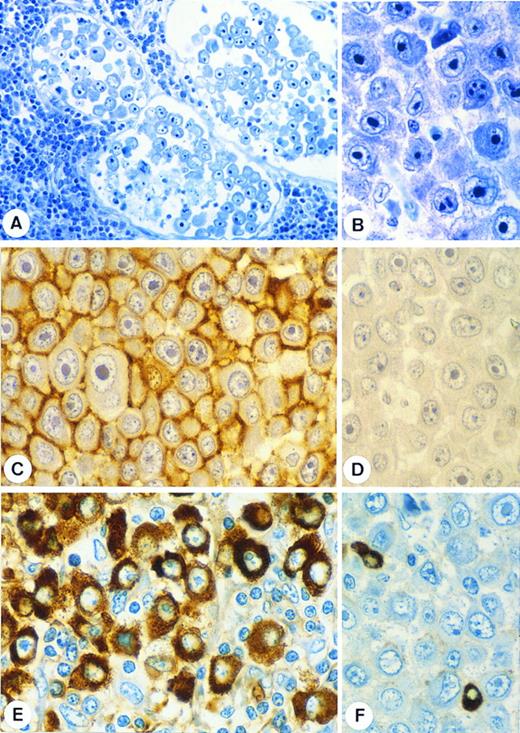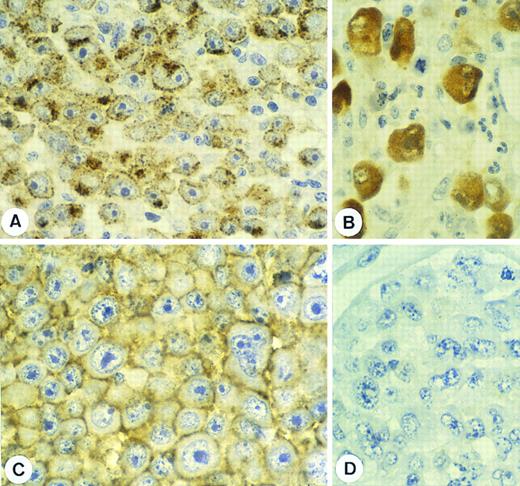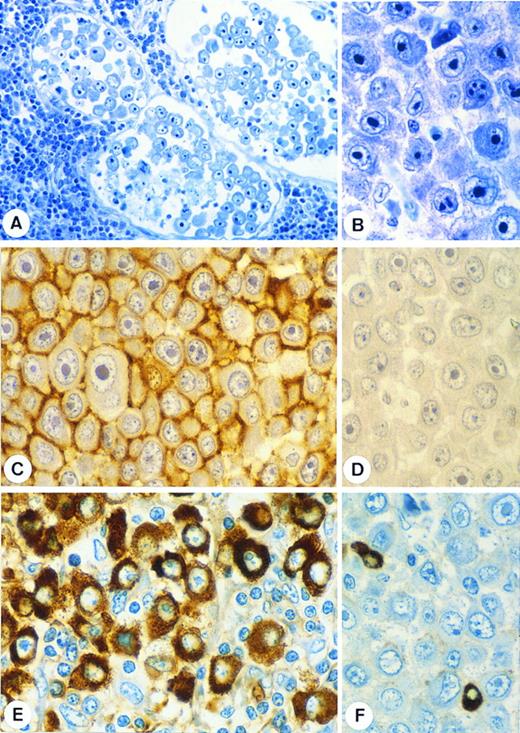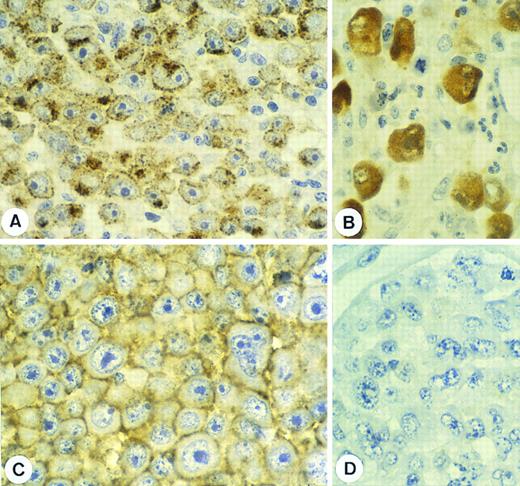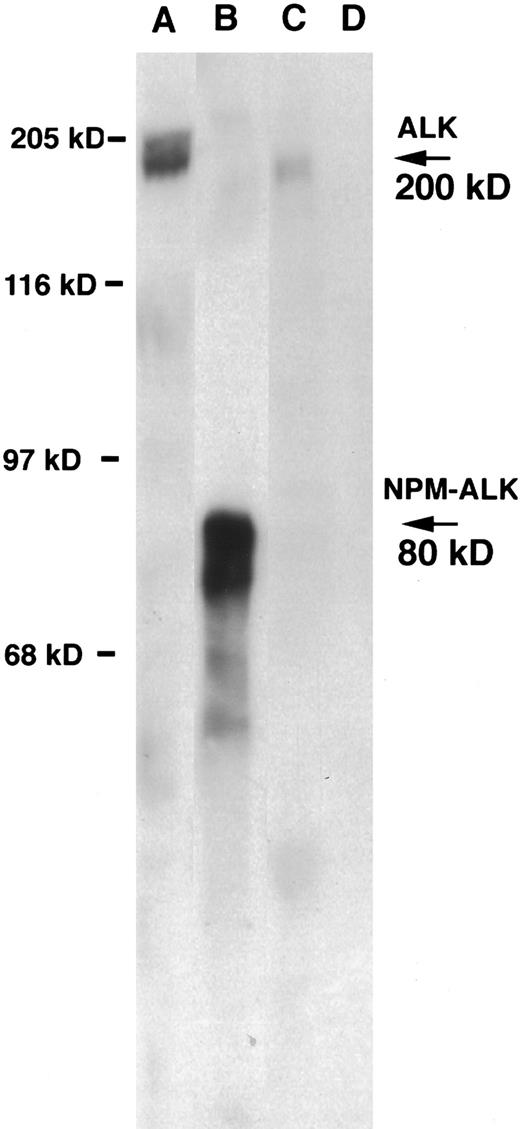Abstract
Seven cases of large B-cell lymphoma which define a previously unrecognized subgroup are reported. Morphologically they are comprised of monomorphic large immunoblast-like cells, containing large central nucleoli, which tend to invade lymphatic sinuses. Superficially they resemble anaplastic large cell lymphoma (ALCL) but they lack CD30. These lymphomas express epithelial membrane antigen (as do ALCL), but also contain intracytoplasmic IgA of a single light chain type (five cases) and an endoplasmic reticulum–associated marker detected by antibody VS38. They lack lineage-associated leukocyte antigens with the exception of CD4 (5 of 5 cases) and CD57 (5 of 7 cases). They are labeled by antibodies detecting both the intracytoplasmic and extracellular regions of the ALK receptor kinase, suggesting that they express the full-length form of this molecule. This was confirmed by Western blotting (in the one case tested) which showed a band of 200 kD in tumor cell lysates, and by polymerase chain reaction (PCR) amplification of mRNA encoding intracellular and extracellular ALK sequences (in the two cases tested). There was no evidence by cytogenetics (one case analyzed) or reverse transcriptase-PCR (three cases tested) of the 2; 5 translocation or the resultant NPM-ALK gene, as is commonly found in ALCL. All but one of the patients were male and all but one were adults, and in all but the latter case the disease followed an aggressive course.
MANY CASES of anaplastic large cell lymphoma (ALCL) are associated with a reciprocal translocation, t(2; 5)(p23; q35),1-6 which juxtaposes the gene at 5q35 encoding nucleophosmin (NPM), a nucleolar-associated phosphoprotein, with the gene for a receptor tyrosine kinase, the anaplastic lymphoma kinase (ALK), at 2p23.7 The resultant hybrid gene encodes a chimeric 80-kD protein in which 40% of the N-terminal portion of NPM is fused to the complete intracytoplasmic portion of ALK.7
Polyclonal2 and monoclonal8 antibodies (MoAbs) recognizing the intracellular portion of ALK react with both NPM-ALK protein and with the full-length ALK protein but no normal lymphoid cells express full-length ALK, and in consequence, immunostaining with anti-ALK has been used as a means of detecting ALCL cases carrying the 2; 5 translocation.4,6,8 However, in two recent studies of a large number of lymphoid neoplasms, we noted that immunostaining with anti-ALK can be found not only in classical ALCL cases but also in occasional cases in which the t(2; 5) is absent.6 8 In the present study we describe seven such cases and document their unusual morphologic and immunophenotypic features. The ALK staining appears to be due to the expression not of a chimeric protein (as in classical ALCL) but of full-length ALK receptor. Therefore, we suggest that they constitute a rare novel subtype of high-grade non-Hodgkin's lymphoma, sharing a common underlying molecular abnormality.
MATERIALS AND METHODS
Patients
In a previous study of anaplastic large cell lymphoma,9 we noted rare cases of diffuse large cell lymphoma that were morphologically similar to ALCL but which lacked CD30 antigen, although they expressed epithelial membrane antigen (EMA). Two of these cases were negative for t(2; 5) when analyzed by reverse transcriptase-polymerase chain reaction (RT-PCR) but gave strong positive immunohistochemical staining for ALK protein.6 8 We then searched our in-house and consultation files for cases meeting similar immunomorphologic characteristics seen over the past 10 years by one of us (G.D.) and found five additional cases.
Tissue Samples
All samples were peripheral lymph node biopsies and all patients were serologically negative for human immunodeficiency virus. Biopsy specimens had been mainly fixed in ethanol based Bouin's fluid (Duboscq-Brasil). Sufficient frozen tissue was available for immunostaining in 5 cases, for RT-PCR in 3 cases, and for Southern and Western blot analyses in 1 case.
Immunostaining
ALK1 MoAb8 was used as undiluted tissue culture supernatant. The t(2; 5)-positive cell line SU-DHL1 was used as a positive control and the t(2; 5)-negative T-cell line CEM and frozen sections of reactive lymph nodes served as negative controls. The antibody was also characterized by immunostaining 80 cases of CD30+ ALCL, 40 cases of diffuse large B-cell lymphoma, and 60 cases of Hodgkin's disease8 (and unpublished results). All seven cases analyzed in this study were also immunostained with a polyclonal antiserum (diluted 1/1,000) reactive with the extracellular region of the ALK receptor.10 This polyclonal antiserum (ALK-EC) was prepared by immunizing rabbits with the entire extracellular portion of the receptor (expressed in COS cells as recombinant protein).
The epitopes detected by both of these antibodies are denatured by most fixatives and immunostaining on paraffin sections was performed following the antigen retrieval method described by Shi et al11 with some modifications.6,12 Briefly, sections were deparaffinized, placed in plastic jars containing 350 mL of 10 mmol/L Na-citrate buffer (pH 6), and heated in a microwave oven (Whirlpool model; Norrkoping, Sweden) at 750 W for cycles of 15 minutes and 10 minutes, respectively. The slides were removed from the oven and allowed to cool for 30 minutes at room temperature. After washing in water, endogenous peroxidase was blocked with 0.3% hydrogen peroxide in methanol for 30 minutes. The slides were then rinsed in water and in phosphate-buffered saline (PBS) before immunostaining with antibody ALK1. Staining was performed by the streptavidin-biotin-peroxidase complex (ABC) method using the Dako StreptABComplex/HRP Duet (Mouse/Rabbit) kit (Dako, code No. K492; Copenhagen, Denmark).12
In two cases, immunostaining was also performed on biopsy specimens fixed and embedded by the previously described ModAMeX method,13 which was developed for simultaneous study of cell morphology and fixation-sensitive leukocyte differentiation antigens. Immunostaining of this material was performed using the APAAP immunoalkaline-phosphatase procedure.14
All cases were also immunostained in cryostat sections and (when possible because of the resistance of the epitope) in paraffin sections with antibodies against leukocyte common antigen (CD45), against B-cell antigens (CD19, CD20, CD22, CD75, and CD79a),15,16 against heavy and light chains of Ig, against the endoplasmic reticulum–associated molecule recognized by antibody VS38,17 against T-cell–associated antigens (CD2, CD3, CD4, CD5, CD8, CD43, and CD45RO), and against monocyte/macrophage-associated antigens (CD68, CD14). All of these cases were also immunostained for antigens expressed by classical ALCL cells, CD30, EMA, CD15, and with two antibodies from our laboratory, BNH.918 and CBF.78,12 known to react with ALCL. Anticytokeratin antibodies KL-1 and MNF116 were used for excluding a possible metastatic carcinoma. Antibodies were obtained from commercial sources (Dakopatts, Copenhagen, Denmark; Becton Dickinson, Mountain View, CA; Immunotech Marseille, France) or from the authors' laboratories.
RT-PCR
As previously described,6 total RNA was extracted from 20 frozen sections of 5-μm thickness using the method of Chomczynski and Sacchi.19 RNA extracted from the t(2; 5)-positive SU-DHL1 cell line (gift of M. Cleary, Stanford University Medical Center, Stanford, CA) and the t(2; 5)-negative CEM T-cell line (American Type Culture Collection [ATCC], Rockville, MD; CCL 119) were used as positive and negative controls, respectively. Reverse transcription was performed from 10 μg of total RNA for 90 minutes at 42°C using oligonucleotide d(T)16 (Pharmacia, Uppsala, Sweden). cDNA quality was checked by amplifying a 461-bp fragment of the β-actin housekeeping gene, between primers ACT1: 5′ TCA TGT TTG AGA CCT TCA A 3′ and ACT2: 5′ GTC TTT GCG GAT GTC CAC G 3′.
Detection of NPM-ALK mRNA.As previously described,6 a seminested RT-PCR was performed using the 5′ NPM (5′-TCCCTTGGGGGCTTTGAAATAACACC-3′ ) and 3′ ALK (5′-CGAGGTGCGGAGCTTGCTCAGC-3′ ) primers for the first round. The second round used the 3′ALK primer in conjunction with the NPM-ALK junction oligonucleotide (5′-AGCACTTAGTAGTGTACCGCCGGA-3′ ) (98-bp product) described by Morris et al.7
Detection of ALK mRNA.To detect transcripts for the cytoplasmic portion of ALK (ie, the portion present in NPM-ALK), two primers based on the ALK cDNA sequence10 were used: ALK-2S: 5′ GCT GAG CAA GCT CCG CAC CTC GAC 3′ (position 4148-4171 of the full-length normal ALK cDNA; clone RMS17-2); and ALK-0: 5′ CCC GCC ATG AGC TCC AGC AGG ATG 3′ (position 4513-4490). Transcripts encoding the extracellular portion of ALK were detected using two primers located in the region encoding this portion (S.W.M., unpublished results, 1995): ALK-EC1: 5′ CCA TCT CCT TCT CCT GAT TAT TTT 3′ (position 1611-1634); ALK-EC2: 5′ CAC TGC AGA CAA GCT GGG GTT 3′ (position 2162-2142). Two rounds of PCR were used to amplify ALK cDNA. The first round was performed from 0.2 μg total cDNA in a final volume of 25 μL PCR buffer containing 600 nmol/L of each primer, 500 μmol/L deoxynucleotide triphosphate, 1.5 mmol/L MgCl2 , and 0.75 unit of Goldstar DNA polymerase (Eurogentec, Liège, Belgium) using an automated thermal cycler (Hybaid, TR3 Omnigene, Teddington, UK). After 2 minutes of denaturation, 30 cycles of amplification were performed as follows: 95°C for 45 seconds, 68°C for 45 seconds, and 72°C for 20 seconds. The second amplification was performed with the same conditions from 1 μL of the first-round PCR product. PCR products were electrophoresed on 1.2% agarose gel and visualized with ethidium bromide staining.
In Situ Hybridization for Ig κ and λ mRNA
Due to the difficulties in interpreting Ig light chain restriction in routine paraffin sections, Ig light-chain mRNA was detected by in situ hybridization with biotinylated (nonisotopic) oligonucleotide probes (courtesy of Dako). The probes contain “cocktails” of oligonucleotides, 15 for κ constant regions and 11 for λ constant regions.20
Epstein-Barr Virus (EBV) Detection
EBV was detected by immunohistochemistry with anti-LMP1 antibody (latent membrane protein 1) and by in situ hybridization for EBER RNAs (EBER 1 and 2).21
Southern Blotting Analysis
ALK gene rearrangement. ALK gene rearrangement was assessed using a cDNA probe of 366 bp, obtained by purification of the ALK RT-PCR product. This fragment was sequenced using an original protocol22 with DeepVent(exo-) DNA polymerase (New England Biolabs, Beverly, MA) and α-35S-dATP and corresponded to the ALK cDNA sequence published by Morris et al.7 The probe was labeled with 25 μCi of α-32PdCTP using the NEBlot kit (New England Biolabs).
DNA was extracted from frozen tumor fragments or cell line cells after solubilization in 5 mol/L guanidium isothiocyanate (GITC), 50 mmol/L Tris pH 8, and 1% mercaptoethanol by gentle agitation at room temperature. The lysate was then dialyzed three times using 100 vol of Tris 10 mmol/L pH 8, EDTA 1 mmol/L, NaCl 10 mmol/L (buffer A), before being treated at 37°C successively with 100 μg/mL RNase (Sigma) for 2 hours, and with 100 μg/mL Proteinase K (Merck, Chelles, France) for 2 to 4 hours. The solution was then extracted several times with equal volumes of phenol and chloroform-isoamylalcohol (24:1) and again dialyzed against buffer A. DNA aliquots (5 μg) were digested with BamHI, EcoRI, or Kpn I enzymes (New England Biolabs), as recommended by the manufacturer and electrophoresed in 0.7% agarose gel overnight at 50 V in TBE buffer. DNAs were then depurinated, denaturated, and transferred onto nylon membrane (Genescreen Plus; Dupont, Boston, MA), using 0.4 mol/L NaOH as transfer solution. After transfer, the membrane was rinsed, dried, and prehybridized in 10% dextran sulfate, 1 mol/L NaCl and 1% sodium dodecyl sulfate (SDS) for 2 hours at 65°C.
After addition of the denatured labeled probe, filters were hybridized overnight at 65°C, then washed according to manufacturer's recommendations and finally exposed to Kodak X-Omat AR films (Eastman Kodak, Rochester, NY) using intensifying screens at −80°C.
IgH gene rearrangements.The configuration of Ig heavy chain genes was investigated in one case (no. 1) with a probe specific for the JH locus (2.5 kb) as previously described.23 In two additional cases (nos. 4 and 6), IgH gene rearrangements were analyzed by semi-nested PCR using consensus primers, FR3a and FR2a, in conjunction with LJH and VLJH primers.24
Cytogenetics
In one case (no. 1) karyotypic analysis was performed by standard procedures.
Western Blotting
Cell lysates were prepared as previously described8 from the Rh30 rhabdomyosarcoma cell line (that expresses the full-length ALK receptor), from the t(2; 5) positive Karpas 299 cell line, from a frozen lymph node biopsy from case 1 (see Table 1) and from normal tonsil. Fifty micrograms of protein was resolved by SDS-polyacrylamide gel electrophoresis (SDS-PAGE) in a 7.5% gel under reducing conditions and then transferred onto Immobilon PVDF membranes (Millipores UL Ltd, Watford, UK) by semi-dry electroblotting. After blocking in TBS containing 5% nonfat milk for 1 hour at 37°C, the membranes were incubated for 30 minutes with antibody ALK1 and washed in TBS containing 0.1% Tween 20. The bound antibody was detected by incubation with HRP-conjugated goat anti-mouse antibody (Dako a/s code P0447) followed by chemiluminescent detection with Amersham ECL reagents (Amersham, UK).
RESULTS
Clinical Features
All but one of the patients were male and all but one were adults, the median age being 51 years (range, 15 to 67 years). There was no remarkable past history except for one patient who had longstanding chronic osteomyelitis. Patients tended to present with advanced disease (stage III or IV, 5 cases; stage II, 1 case; stage I, 1 case). Lymphadenopathy at multiple sites was common (5 cases), but splenomegaly was noted in only one case (no. 1). Only two patients showed mediastinal lymph node enlargement. The peripheral blood at diagnosis was unremarkable except for one patient who presented with anemia and autoimmune thrombocytopenia. This patient also had a moderate and variable lymphocytosis (5,000/μL) with an increase of CD8 cells. Polyclonal hypergammaglobulinemia (>20 g/L) was noted in 3 cases.
Morphologic and phenotypic features of the lymphomas described in this report. (A and B) Characteristic sinusoidal growth pattern and cellular morphology (Giemsa stain). (C through F ) Immunostaining reactions. EMA is strongly expressed (C) but CD30 is absent (D). Neoplastic cells express IgA (E) but in a section stained for IgM (F ) only plasma cells are stained. (Immunoperoxidase staining with nuclear counterstain.)
Morphologic and phenotypic features of the lymphomas described in this report. (A and B) Characteristic sinusoidal growth pattern and cellular morphology (Giemsa stain). (C through F ) Immunostaining reactions. EMA is strongly expressed (C) but CD30 is absent (D). Neoplastic cells express IgA (E) but in a section stained for IgM (F ) only plasma cells are stained. (Immunoperoxidase staining with nuclear counterstain.)
Patients received various chemotherapy regimens including M-BACOD (2 cases accompanied by radiotherapy in 1 case), B-CHOP (1 case), MOPP associated with radiotherapy (1 case), ACVBP (2 cases), and COPAd-cytosine-arabinoside (1 case). During the course of the disease 1 patient developed skin nodules, 1 bone lesions, and 1 brain involvement. In 4 patients (cases 1, 3, 4, and 7), only partial remission was achieved and survival was short (range, 9 to 33 months). However, 1 patient (case 2), a 15-year-old boy who presented with stage I disease and was treated with COPAd-cytosine-arabinoside, is in complete remission 13 years after diagnosis. One additional patient (case 6) is also in complete remission 14 months after diagnosis. One patient (case 5) was lost to follow-up at 11 months.
Morphologic Features
The lymph node architecture was obliterated in all cases but some preserved sinuses were recognizable. A prominent sinusoidal infiltration by malignant cells was a common feature (Fig 1A). In 4 cases, besides the massively involved lymph nodes, small lymph nodes could be found which had normal architecture but in which large numbers of malignant cells were present in lymphatic sinuses. In 6 cases, this sinusoidal pattern had led to an initial diagnosis of metastatic carcinoma or melanoma. Necrotic areas were noted in all but 2 cases.
The neoplastic cell morphology was similar in all cases, with a monomorphic appearance and very large immunoblastic-like cells with round nuclei and large single central nucleoli (Fig 1B). The cytoplasm was basophilic and sometimes a paranuclear hof was seen, suggesting plasmoblastic differentiation. Binucleate cells resembling Reed-Sternberg cells were seen in all cases and were associated with malignant giant cells in 1 case. Mitoses were numerous. Plasma cells were numerous in 3 cases but no cells with intermediate morphology between mature plasma cells and malignant cells were found. Histiocytes and granulocytes were mainly found in the vicinity of necrotic areas.
In 1 case (no. 7) the large immunoblastic-like cells were present but were associated with a larger population of smaller neoplastic cells, whose nuclei contained two to three nucleoli.
Immunohistochemical and In Situ Hybridization Findings
Expression of EMA and lack of CD30.The hallmark of these tumors was the strong expression of EMA (Fig 1C) and absence of CD30 (Fig 1D). The strong staining for EMA picked out the sinusoidal growth pattern. Positive staining was mainly associated with the cell membrane but was sometimes accompanied by a dotlike staining in the Golgi area (Fig 1C). Cytokeratin was not detectable in any neoplastic cells.
ALK protein expression.In all but 1 case virtually all malignant cells were strongly positive with antibody ALK-1. The staining was restricted to the cytoplasm of malignant cells and appeared as scattered granules, usually associated with a clump of staining in the Golgi area (Fig 2A). In 1 case (no. 7) ALK-1 staining appeared as tiny granules, localized to the Golgi area in a proportion of cells. In contrast to CD30+ ALCL6 8 we did not observe nuclear or nucleolar staining, even in frozen sections (Fig 2B).
Expression of ALK protein. (A) Staining for the intracellular portion of ALK protein (antibody ALK1) is seen as granular cytoplasmic staining associated with a dot-like reaction in the Golgi area. (B) The same antibody gives a diffuse cytoplasmic and nuclear labeling of a classical ALCL expressing the chimeric NPM-ALK protein. (C) Staining with an antibody (ALK-EC) against the extracellular portion of the ALK molecule shows a membrane associated labeling pattern. (D) A classical ALCL case expressing NPM-ALK is negative with this antibody (immunoperoxidase staining with nuclear counterstain).
Expression of ALK protein. (A) Staining for the intracellular portion of ALK protein (antibody ALK1) is seen as granular cytoplasmic staining associated with a dot-like reaction in the Golgi area. (B) The same antibody gives a diffuse cytoplasmic and nuclear labeling of a classical ALCL expressing the chimeric NPM-ALK protein. (C) Staining with an antibody (ALK-EC) against the extracellular portion of the ALK molecule shows a membrane associated labeling pattern. (D) A classical ALCL case expressing NPM-ALK is negative with this antibody (immunoperoxidase staining with nuclear counterstain).
The polyclonal ALK-EC antibody, reacting with the extracellular portion of the ALK receptor, gave clear membrane staining of a proportion of malignant cells (Fig 2C). The percentage of positive cells varied from case to case, and some cells also showed cytoplasmic staining. This antibody cross-reacted to some extent with plasma cells but, as expected, the t(2; 5)-positive SU-DHL1 cell line and 3 cases of t(2; 5)-positive ALCL were negative (Fig 2D).
Expression of leukocyte-associated antigens.All cases expressed the leukocyte common antigen (CD45) but except for 2 cases (no. 1 and 5), the staining was weak to moderate, and often present in only a proportion of malignant cells. The 5 cases (nos. 1, 2, 4, 6, and 7) investigated in frozen sections clearly expressed the CD4 antigen, but the staining was weaker than that of surrounding nonneoplastic T lymphocytes. Malignant cells were negative for other T-cell (CD2, CD3, CD5, CD7, CD8, CD43, CD45RO), B-cell (CD19, 20, 21, 22, 75, 79a), and macrophage-associated markers (CD14, CD68), whereas nonneoplastic cells were labeled as expected. None of these cases were positive with the CBF.78 and BNH.9 antibodies, which react with the majority of CD30+ ALCL cases.12 18 The majority of malignant cells in all cases were labeled by antibody VS38, which reacts with an endoplasmic reticulum–associated molecule in plasma cells and some large B-cell lymphomas. In 5 of the 7 cases a proportion of lymphoma cells were labeled for CD57 natural killer (NK)-associated antigen but the intensity varied from cell to cell, with some cells being strongly positive whereas others were moderately to weakly stained or even negative.
Expression of Igs.Immunohistochemistry using antibodies to Ig heavy chains showed strong positive staining for IgA in 5 of 7 cases (Fig 1E and F ).
Light-chain restriction could be demonstrated either by immunohistochemistry or by in situ hybridization in 6 of 7 cases (nos. 1, 2, 3, 5, 6, and 7) (λ = 3 cases; κ = 3 cases) (Table 1).
Presence of NPM-ALK and ALK mRNA
No NPM-ALK transcripts were found by RT-PCR in the 3 cases tested (nos. 1, 4, and 6). Positive and negative controls gave the expected reactions (Fig 3). The 2 cases (nos. 1 and 6) tested for ALK mRNA corresponding to the intracellular portion of ALK yielded the expected band of 366 bp (Fig 4). The same cases tested for ALK mRNA corresponding to the extracellular portion of ALK yielded the expected band of 552 bp (data not shown).
RT-PCR with primers detecting NPM-ALK transcripts. Total mRNAs extracted from the t(2; 5)-bearing SU-DHL1 cell line (lane C+) and a t(2; 5)-positive case of ALCL (lane 2) yield the expected band of 98 bp. RNAs from the CEM T-cell line (C−), a t(2; 5)-negative ALCL (lane 1) and from two tumors under study (cases 1 and 6) (lanes 3 and 4) are negative for hybrid NPM-ALK mRNA. NoT, no template cDNA; MW, molecular-weight markers.
RT-PCR with primers detecting NPM-ALK transcripts. Total mRNAs extracted from the t(2; 5)-bearing SU-DHL1 cell line (lane C+) and a t(2; 5)-positive case of ALCL (lane 2) yield the expected band of 98 bp. RNAs from the CEM T-cell line (C−), a t(2; 5)-negative ALCL (lane 1) and from two tumors under study (cases 1 and 6) (lanes 3 and 4) are negative for hybrid NPM-ALK mRNA. NoT, no template cDNA; MW, molecular-weight markers.
RT-PCR with primers detecting ALK mRNA corresponding to the tyrosine kinase domain of the ALK receptor. Total RNAs extracted from the t(2; 5)-bearing SU-DHL1 cell line (lane C+) and a t(2; 5)-positive case of ALCL (lane 1) show the expected band of 366 bp. Note that the two cases (cases 1 and 6) under study (lanes 2 and 3), which are negative for NPM-ALK transcripts, also show a band of 366 bp. RNA from the CEM T-cell line yielded no product (C−). NoT, no template cDNA, MW, molecular-weight markers.
RT-PCR with primers detecting ALK mRNA corresponding to the tyrosine kinase domain of the ALK receptor. Total RNAs extracted from the t(2; 5)-bearing SU-DHL1 cell line (lane C+) and a t(2; 5)-positive case of ALCL (lane 1) show the expected band of 366 bp. Note that the two cases (cases 1 and 6) under study (lanes 2 and 3), which are negative for NPM-ALK transcripts, also show a band of 366 bp. RNA from the CEM T-cell line yielded no product (C−). NoT, no template cDNA, MW, molecular-weight markers.
Southern Blot Analysis
Case 1 did not show any evidence of ALK gene rearrangement whereas this was detected in the t(2; 5)-positive SUDH-L1 cell line and in a t(2; 5)-positive ALCL case (data not shown). Among the 3 cases investigated (nos. 1, 4, and 6), clonal IgH gene rearrangement was found in 1 case (no. 1) (data not shown).
Cytogenetics
In the single case analyzed (no. 1), malignant cells showed a trisomy 12 associated with a reciprocal translocation involving two of the three chromosomes 12:47 XY, +12, t(12; 12)(p11; q11).
Western Blotting Studies
Antibody ALK1 recognized a protein of 200 kD in the cells from case 1 (Fig 5, lane C), indicating the presence of the full-length ALK protein in the tumor cells. Controls were provided by analysis of the Rh30 rhabdomyosarcoma cell line, in which the full-length 200-kD ALK protein was detected7 8 (Fig 5, lane A), and the Karpas 299 cell line that contains the 80-kD NPM/ALK chimeric protein (Fig 5, lane B), and normal tonsil, which contains no ALK protein (Fig 5, lane D).
Western blotting with antibody ALK1. Antibody ALK1 recognizes a protein of 200 kD, corresponding to the normal ALK receptor, in the Rh30 rhabdomyosarcoma cell line (lane A), whereas only a smaller band of 80 kD, representing NPM-ALK, is detected in the t(2; 5)-positive Karpas 299 cell line (lane B). The antibody also detects the 200-kD ALK protein in cells from case 1 (lane C). The negative control (normal tonsil) is shown in lane D.
Western blotting with antibody ALK1. Antibody ALK1 recognizes a protein of 200 kD, corresponding to the normal ALK receptor, in the Rh30 rhabdomyosarcoma cell line (lane A), whereas only a smaller band of 80 kD, representing NPM-ALK, is detected in the t(2; 5)-positive Karpas 299 cell line (lane B). The antibody also detects the 200-kD ALK protein in cells from case 1 (lane C). The negative control (normal tonsil) is shown in lane D.
DISCUSSION
The seven cases in this study represent a previously unrecognized subtype of B-cell lymphoma with distinctive morphologic, phenotypic, and genetic features. Although the neoplastic cells are large and show a tendency to sinusoidal invasion they differ from ALCL25,26 in their monomorphic appearance, having round nuclei containing single prominent nucleoli. In addition, ALCL express CD30+, often associated with EMA,9,26 and are of T-cell or “null” phenotype,26 whereas the present cases lack CD30 and are probably of B-cell origin. In addition, other markers commonly found in ALCL, such as BNH.918 and CBF.78,12 were also absent. We have previously shown that EMA is not specific for cells of epithelial origin, being also found on reactive and neoplastic plasma cells and some non-Hodgkin's lymphoma, including ALCL.9 27
These cases lack T-cell– (except for CD4) and B-cell–associated antigens (see Table 1). However, on the basis of the clonal IgH gene rearrangement, light chain restriction and cytoplasmic monotypic IgA, they appear to be of B-cell origin and are presumably related to the plasma cell stage because they react with a plasma cell marker detected by VS38 antibody.17 Their plasma cell differentiation could account for the lack of CD20 since this molecule is lost by this stage in B-cell maturation. In contrast, normal plasma cells can express CD79a,15 16 but this is not found in all plasma cells, which may account for its absence from the tumors in this study.
The expression of CD4 by an Ig-secreting lymphoma is an unexpected finding but CD4 is known not to be restricted to T lymphocytes, being found also on monocytes/macrophages. However, the macrophage-associated antigen CD68 was absent so that there is no obvious explanation for CD4 expression by these B-cell lymphomas. The CD4 gene is located on chromosome 12 (p12-pter) and one may speculate that the trisomy 12 associated with a reciprocal translocation t(12; 12)(p11; q11) involving two of the three chromosomes 12 in one case might play a role, but further studies on a larger number of cases are required. Another unexpected finding is the expression in five cases of the CD57 NK-associated antigen by a proportion of lymphoma cells. The expression of NK markers has been reported in T-cell lymphomas but, to the best of our knowledge, not in B-cell lymphomas.28
The most interesting feature of these lymphomas (in view of the potential insight it may offer into their molecular pathogenesis) is the expression of ALK protein. This protein appears to be full-length ALK receptor (and not a chimeric molecule), both because it was of the expected molecular weight on Western blotting and because it reacted with antibodies against both intracellular and extracellular regions (the latter being lost in the chimeric NPM-ALK protein). Furthermore, mRNA encoding the extracellular region could be amplified in the two cases studied. Expression of full-length ALK receptor, which is so far without precedent in lymphoid neoplasia, implies (by analogy with genes such as BCL-1 and TAL-1)29 that rearrangement has caused its transcriptional activation. However, under the conditions of Southern hybridization analysis used, involving three different restriction enzymes, we could find no evidence of an altered ALK gene configuration.
Therefore, the present study indicates that large B-cell lymphomas exist which superficially resemble ALCL but which lack the t(2; 5) translocation and express full-length ALK receptor kinase. This subtype of large cell lymphoma is probably uncommon, but we suspect that some cases may have been misdiagnosed as ALCL, immunoblastic lymphoma, or even as undifferentiated carcinoma because of the strong expression of EMA together with the weak expression or lack of CD45.
ACKNOWLEDGMENT
We thank Prof S. Chittal for helpful discussion and critical reading of the manuscript; and Prof Ph. Colombat, Prof F. Fetissof, and Dr Th. Rousset for each providing a case included in the present study. We are also grateful to M. March for his excellent technical assistance.
Supported by “Association pour la Recherche sur le Cancer (ARC No. 6229),” the “Délégation à la Recherche Clinique,” the Leukemia Research Fund of Great Britain; the National Cancer Institute (NCI) Grants No. CA 01702 and CA 69129 (S.W.M.), the NCI Cancer Center CORE Grant No. CA 21765, and by the American Lebanese Syrian Associated Charities (ALSAC), St Jude Children's Research Hospital, Memphis TN.
Address reprint requests to Georges Delsol, MD, Laboratoire d'Anatomie Pathologique, CHU Purpan, Place du Dr Baylac, 31059, Toulouse Cedex, France.

